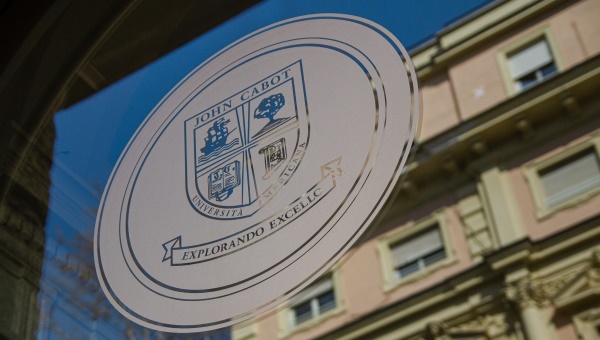Panel Discussion on European Parliament's Study on Contemporary Forms of Slavery

Professor Silvia Scarpa
“We cannot solve our problems with the same thinking we used when we created them.” Moderator Marco Ricceri, Secretary General of the EURISPES Institute quoted Albert Einstein to open “Contemporary Forms of Slavery: A Panel Discussion on the European Parliament’s Study Authored by JCU Professor Silvia Scarpa.”
The event, sponsored by the Guarini Institute for Public Affairs, was held on April 16 under the patronage of the International Labour Organization (ILO), the EURISPES Institute and the European Commission Representation in Italy.
The European Parliament’s Study on Contemporary Forms of Slavery was commissioned to JCU Professor Silvia Scarpa during the summer of 2018. The first draft was publicly presented during a Hearing of the European Parliament’s (EP) Subcommittee on Human Rights (DROI) on “Contemporary forms of slavery in third countries” held on 11 October 2018 in Brussels (Belgium).
Contemporary Forms of Slavery
Scarpa opened the discussion clarifying that the concepts of “contemporary forms of slavery,” “contemporary slavery,” “modern slavery” and, finally, “modern-day slavery” are nowadays frequently used by many relevant actors in global governance. However, the concept of “contemporary forms of slavery” remains undefined in international law; the issue is relevant not only in semantic terms but also from a legal and a political perspective. Unfortunately, a lack of clarity on the concept’s content and its boundaries negatively affects many activities, including coordinated action in the fight against the forms of exploitation constituting contemporary forms of slavery; the collection of relevant data and calculation of meaningful estimates; and the setting of priorities for future action. However, the tendency to use the concept of contemporary forms of slavery as an umbrella term, covering multiple exploitative practices, is readily apparent.
Scarpa also commented on the inadequacy of the three regimes of international law on slavery, human trafficking and forced labor relying on the ‘slave auctions’ that took place in Libya during November 2017 as a test case. Footage released by CNN showed men actually being sold at an auction in Libya. This case perfectly meets the requirements for being classified as both slavery and slave trade, but it could not be classified as human trafficking or forced labor. However, if compared with the international law regimes on human trafficking and forced labor, the one on slavery and the slave trade is the least developed one. Therefore, there is a need to reconsider the obsolete international law system on slavery and the standards therein to be generally aligned with those existing in the other two branches of international law, through the adoption of a new treaty.
Scarpa continued by referring to the three United Nations Sustainable Development Goals (SDG), namely SDG 8.7, SDGs 5.2 and 5.3 and SDG 16.2 dedicated to promoting the elimination of multiple forms of contemporary slavery by 2030 (2025 in the case of child labor) and the challenges faced by States in meeting them. Scarpa called upon all participants to be informed and engaged on contemporary forms of slavery, thus promoting a bottom-up approach, and concluded by quoting William Wilberforce, the British Member of Parliament who led the anti-slavery movement in the 19th century: “You may choose to look the other way but you can never say again that you did not know.”
Uniform Laws on Modern Slavery
Parosha Chandran, Professor of Practice in Modern Slavery Law at King’s College and human rights barrister at One Pump Court opened her presentation by commending Professor Scarpa for her study and by referring to frequent gaps in legislation, which render the prosecution of cases incredibly difficult. A leading barrister litigating modern slavery and human trafficking cases in the United Kingdom, she noted how before the adoption of the 2015 UK Modern Slavery Act, transferring and transporting people into Great Britain for exploitative purposes was illegal under the heading of human trafficking. At the same time, the holding of a person for forced labor or other forms of exploitation did not count as an explicit crime. After having discussed this gap, Chandran focused on the disparity between international conventions and their internal implementation by States Parties, which accepted an obligation to implement their standards. While in fact, international conventions may “prohibit” certain acts, such prohibitions need to be rendered effective through the adoption of relevant legislation by States Parties. Finally, Chandran emphasized the need for binding uniform laws on modern forms of slavery. “Without law, you cannot identify. Without identification, you cannot protect,” she noted.
Immigration, human trafficking, and exploitation
The third panelist, Maria Grazia Giammarinaro, United Nations Special Rapporteur on Trafficking in Persons, in Particular Women and Children and Judge in the Civil Court of Rome, stressed the need to develop a framework that both defines what constitutes contemporary forms of slavery and provides a plan for States to work together in fighting against them. Giammarinaro also focused on the concept of vulnerability included in the definition of trafficking in persons and emphasized the link between immigration, human trafficking, and exploitation, a connection that often has political implications. In some countries, threats of potential trafficking in persons have recently been used as an excuse to implement more restrictive immigration laws, rather than focusing on the social vulnerability that migrants experience throughout their trips. Ultimately, the UN Special Rapporteur explained that in all forms of slavery, whether old and new, the main issue is the exploitation of victims, and she proposed a focus on this concept in the near future.
Q&A: Child Soldiers and Business and Human Rights
During the Q&A section of the panel discussion, relevant questions on the difficulties connected with the adoption of a new treaty, the issue of child soldiers in the civil war in Sierra Leone that hit the country between 1991 and 2002, corporate social responsibility and global supply chains were posed to panelists.
On the issue of child soldiers in Sierra Leone, Chandran emphasized that in the past, UN field officers and peacekeepers received no training on how to identify vulnerable groups. Thanks to recent initiatives, however, they now work to recognize actual and potential trafficking victims in the field and provide them with the appropriate aid. Giammarinaro emphasized the difficulties of rehabilitating child soldiers and Scarpa added that the recruitment and use of children under the age of 15 as child soldiers is a war crime, which has been dealt with by the Special Court for Sierra Leone.
Professor Scarpa commented on the idea of a new treaty to eliminate certain loopholes existing in the international law regime on contemporary forms of slavery and on the concept of exploitation, emphasizing how her monograph on Trafficking in Human Beings: Modern Slavery published by Oxford University Press in 2008 already proposed a broad interpretation of this latter concept. She added that the EP Study focuses equally on international customary law in this field and contains multiple recommendations for future action. In conclusion, Scarpa referred to the existence of a “zero draft” of a treaty and a protocol on business and human rights and stressed the importance of finally adopting these two treaties for guaranteeing the respect of human and workers’ rights throughout the global supply chains.
Watch the video of the event on JCUTV
(Daniel Kyei Brobbey and Megan Gower)






